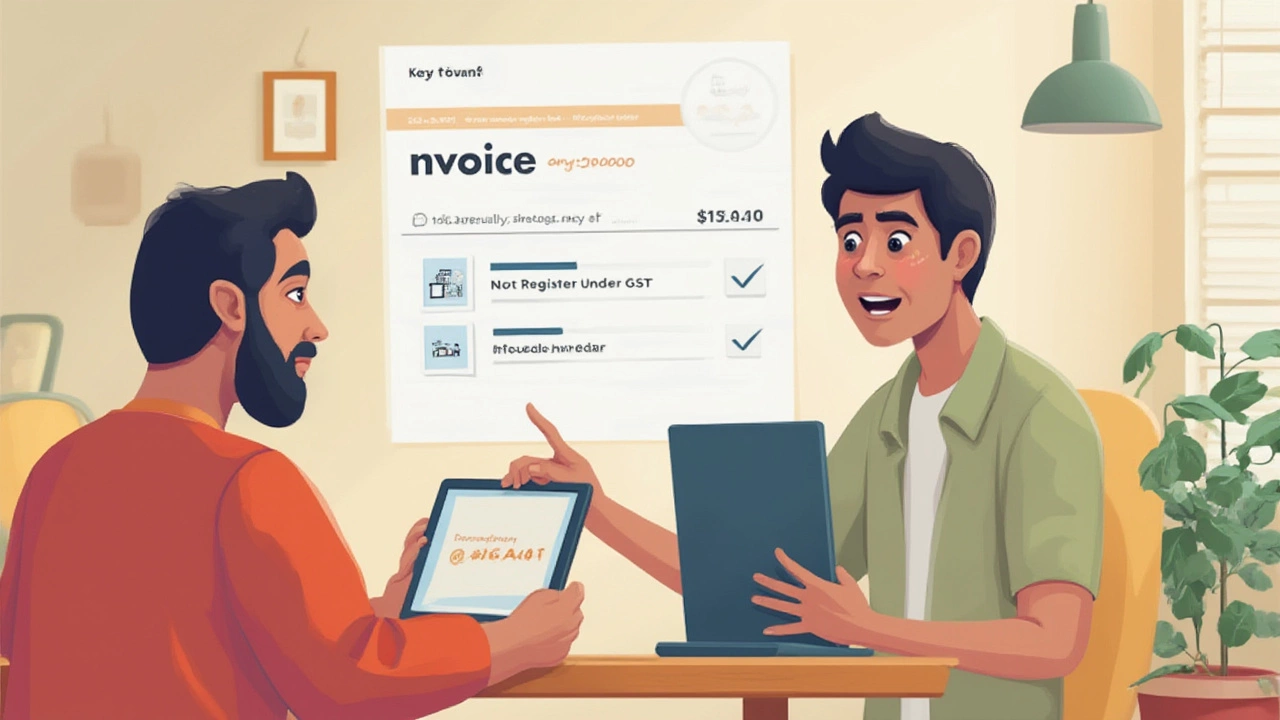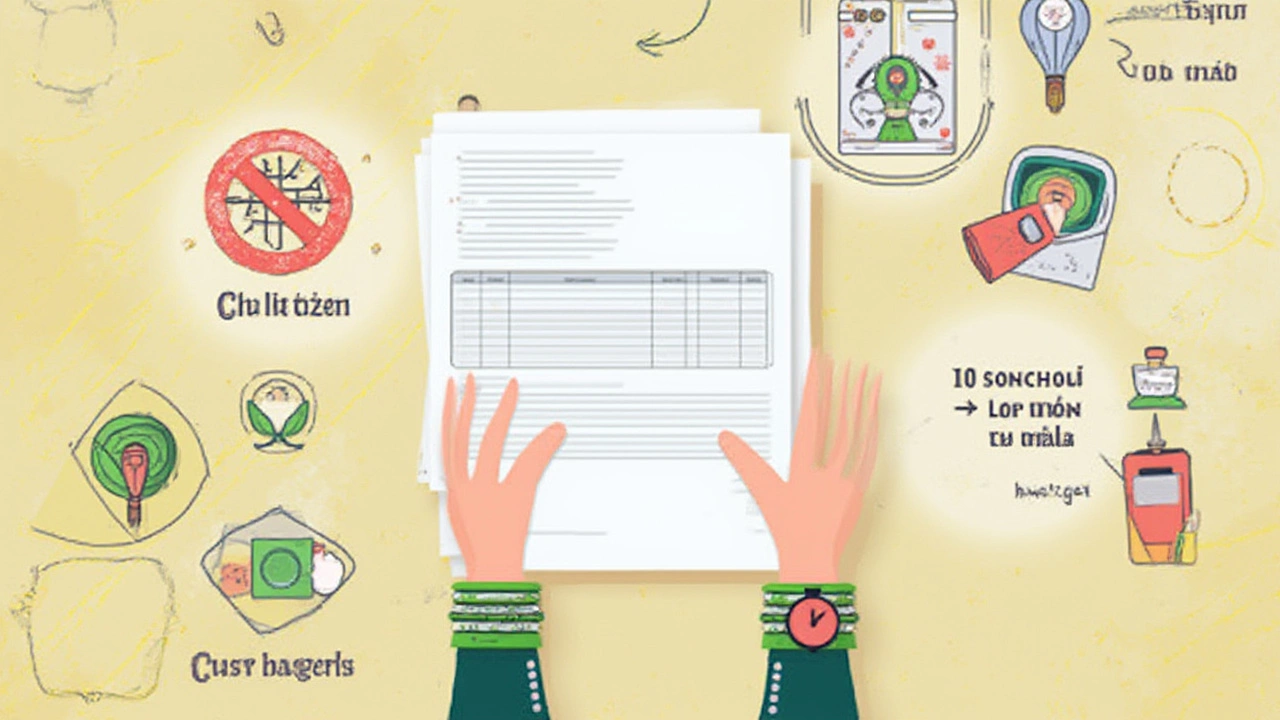Ever thought a piece of paper could be the difference between getting paid fast or chasing your money for weeks? That’s the reality with invoices, especially when you’re not registered under GST in India. People often assume that skipping GST registration means no paperwork, but that’s a recipe for late payments and regulatory headaches. Clients still expect a legit invoice, and good luck scoring big contracts without it. What’s the actual process if GST isn’t on your registration card? The answer isn’t as scary as tax lawyers make it sound, but miss a detail or two, and you’ll be hunting down payments while everyone else moves on.
Why Non-GST Registered Businesses Still Need Invoices
Even if you’re below the GST threshold or provide exempted services, your business doesn’t get a free pass to ignore invoicing. Here’s a fact: every business—registered or not—has to maintain records, especially for income tax and basic client trust. Non-GST invoices don't just help with your own paperwork but build credibility with partners and customers. Legitimate invoices also become proof during disputes, TDS (tax deducted at source) calculations, or when tallying income for bank loans. According to the Income Tax Act and the Indian Contract Act, a simple bill isn’t just optional; it’s the backbone of your financial trail.
In 2023, about 63% of Indian small businesses earning under Rs. 20 lakh stayed outside GST. Still, nearly half of them reported payment delays when failing to provide a formal invoice. If you freelance for a large firm or deal B2B, companies may refuse to release payments unless your invoice checks their compliance list—even if there’s no GST. There’s also something psychological here: an invoice, even with zero tax, signals that you run a real business. Skip it, and you’ll find yourself on the bottom of clients’ priorities when it’s payout time.
Another thing many new business owners miss is that banks and NBFCs often require sales proofs when you apply for business loans. No invoice, no trail. Missing paperwork can lead to big headaches if you’re ever audited. Indian authorities may not chase a tiny transaction, but if your business grows, that pile of unbilled income could raise red flags.
So whether you’re selling handicrafts on Instagram, coding projects from home, or freelancing as a designer, don’t wait for GST registration to get organised. In voices are your personal shield in the money world, and the sooner you make them a habit, the safer your finances become. Plus, getting clients used to paperwork now means fewer arguments (and surprises) if you do eventually cross the GST threshold.
The Right Way to Structure an Invoice Without GST
Worried your invoice will look suspicious or unprofessional without a GST number? Relax—there’s nothing shady about a non-GST invoice as long as you get the basics right. Here’s what’s essential, based on best practices and what Indian clients actually expect to see:
- Invoice title (it should say ‘Bill of Supply’ or simply ‘Invoice’ since ‘Tax Invoice’ is reserved for GST-registered sellers)
- Date of issue
- Unique serial number (keep it sequential for easy reference)
- Your business or personal name
- Your address and contact info
- Client’s name and address
- Description of goods/services
- Quantity and Rate
- Total amount in numbers and words
- Any extra notes (payment terms, bank details for transfer, etc.)
No GSTIN? Just leave out that field instead of making up a fake number or using someone else’s. Instead, you can add a note like “Not registered under GST” or “GST not applicable.” Pro tip: never use the phrase ‘Tax Invoice’ if you’re not GST-registered. That word carries legal weight and using it wrongly can attract fines (Section 122 of GST Act).
As for formats, you don’t need fancy software. A Word or Excel template works, and several free invoicing apps already have non-GST modes. Don’t attach extra tax columns or leave blank boxes lurking—keep it clean or clients start to wonder if you know what you’re doing. If you’re selling to a company, always add your PAN (Permanent Account Number). For freelancers, this is sometimes mandatory if you’re dealing with TDS deductions.
Here’s a simple snapshot of what this could look like:
| Field | Example Entry |
|---|---|
| Invoice No. | INV-2025-072 |
| Date | 27-07-2025 |
| Supplier Name | Dev Singh |
| Supplier Address | Bangalore, Karnataka |
| Client Name | ABC Pvt Ltd |
| Client Address | Mumbai, Maharashtra |
| Item Description | App Design Services |
| Quantity | 1 |
| Rate | Rs. 18,000 |
| Total | Rs. 18,000 (Eighteen thousand only) |
| Notes | Not registered under GST |

Common Mistakes to Avoid with Non-GST Invoicing
It’s easy to get tripped up when you’re new to invoicing. People often copy GST invoices from the web and simply delete the GST field, but that’s a rookie mistake. Here are the traps you’ll want to dodge if you don’t want to arouse suspicion or risk payment delays:
- Using ‘Tax Invoice’ or leaving in GST columns—this confuses clients and can lead to rejection or even complaints.
- Skipping serial numbers or reusing invoice numbers—easy to miss, but can turn audits or recordkeeping into a nightmare.
- Missing PAN details when invoicing larger companies—firms might return the bill and pause payment until you fix it.
- Fuzzy item descriptions—“services rendered” or “project fee” isn’t enough, spell out what you did.
- Incomplete contact info—it matters for both client confidence and your own accounting down the line.
- Forgetting to mention ‘not under GST’ or ‘GST not applicable’ somewhere on the bill—this stops time-wasting clarifications.
If you are dealing with a client for the first time, always send a draft copy for approval if you can. This avoids surprise rejections that waste your time. Make sure to lock your template as a PDF before sending so it can’t be edited easily—many professionals have learned the hard way not to send invoices in Word!
And don’t ever try to ‘charge GST’ if you’re not registered just to look official. If caught, penalty is up to 100% of the tax falsely charged, according to the GST Act, and your com pany’s reputation will take a hit. At the same time, be careful with payment links and QR codes—clients may expect these for online transfers, so be clear and consistent with your details.
On the nitty-gritty side, always keep a backup record. Both soft and printed copies help you in the event you need to prove billing or income (for example, if a client claims later that they paid less or you never delivered.) These days, any invoice you email or WhatsApp is considered valid proof, so make those digital records count. If you’re invoicing internationally, remember to mention currency and convert accordingly to avoid confusion at tax filing time.
How Invoicing Changes if You Register for GST Later
Maybe your business is small now, but what happens if you grow and have to get GST registration down the road? That transition is not just a paperwork shuffle—there are things you’ll need to upgrade fast to avoid compliance issues.
Before GST registration, you use a standard invoice without GST fields. The moment you cross the Rs. 20 lakh (or for some states, Rs. 10 lakh) threshold, you must switch to a GST-compliant invoice—this means adding your GSTIN, showing separate CGST/SGST or IGST columns, and using the term ‘Tax Invoice.’ You’ll also need to start collecting and remitting that tax to the government. Your serial number sequence can continue (for tracking ease), but you can also reset it if you prefer—just inform clients and mark the records for audit clarity.
Here’s a quick comparison:
| Factor | Pre-GST (Non-Registered) | Post-GST Registration |
|---|---|---|
| Invoice Title | Invoice/Bill of Supply | Tax Invoice |
| GSTIN | No | Mandatory |
| Tax Columns | No | Yes (CGST/SGST or IGST) |
| Legal Phrases | Not under GST | GST payable/refundable, HSN/SAC codes |
The key is to notify clients the moment you register and start updating your template across all platforms. For regular B2B clients, some may require you to provide past non-GST invoices as part of their records—this is another reason not to skip on details now. Also, once registered, you cannot use the old invoice format for any taxable supply. If you do, you can face fines or possibly lose GST credits for your clients—which nobody appreciates.
Upgrading your paperwork doesn’t have to be stressful, but set aside time for a crash course in GST-compliant billing the week you get that registration confirmation. The more systematic you are with non-GST invoices today, the easier your transition will be later. Good records mean less time scrambling for paperwork—and less worry about surprises in case of a tax officer’s knock.

Smart Tips for Hassle-Free Invoicing Without GST
There are a handful of pro moves that make invoicing, even without GST, much less of a headache. First, standardise your invoice format from day one, whether you’re earning Rs. 5,000 or Rs. 15,00,000 a year. Clients love knowing what to expect, and it saves you time too. Second, use digital tools or at least a simple Excel/Google Sheets log to track which invoices are unpaid; don’t rely on your memory or random emails.
Add payment terms on every invoice: “Payable within 7 days” or “Late payment attracts 2% penalty per month.” Even if most never read it, these little notes make clients more likely to pay on time and give you something to point to when chasing money. Always include your bank details clearly. If you use an e-wallet or UPI, put those on the bill too.
Don’t be shy about protecting yourself with extra notes. Example: “No GST has been charged as supplier is not registered under GST.” This shuts down questions about missing tax and keeps payments flowing. Back up your invoices in cloud storage, email, or even a WhatsApp folder. Miss an invoice now, and you might be stuck in a paperwork deadlock later, especially if IT authorities come checking years down the line. If you issue more than 30-40 invoices per month (side hustlers, we see you!), consider investing in free invoice generator apps like Vyapar or Zoho Invoice, which let you customise templates and track payments.
When you’re ready to grow, review your revenue each month, not just at the year’s end. The day you're close to the GST limit is the time to plan your registration—not after crossing it and getting stuck in a compliance jam. If you sell physical goods, add the right item codes (HSN) so it looks professional. Service-based? Include your SAC code anyway—it impresses bigger clients and smooths the transition to GST if your fortunes change.
Finally, don’t mix up personal and business income on invoices—keep it strictly business. This helps keep your taxes clean and prevents awkward audits when your hobby suddenly becomes your career. Snag every little advantage you can with professional invoicing, even without GST—it will pay off every single time, both in faster payments and fewer headaches down the line.


